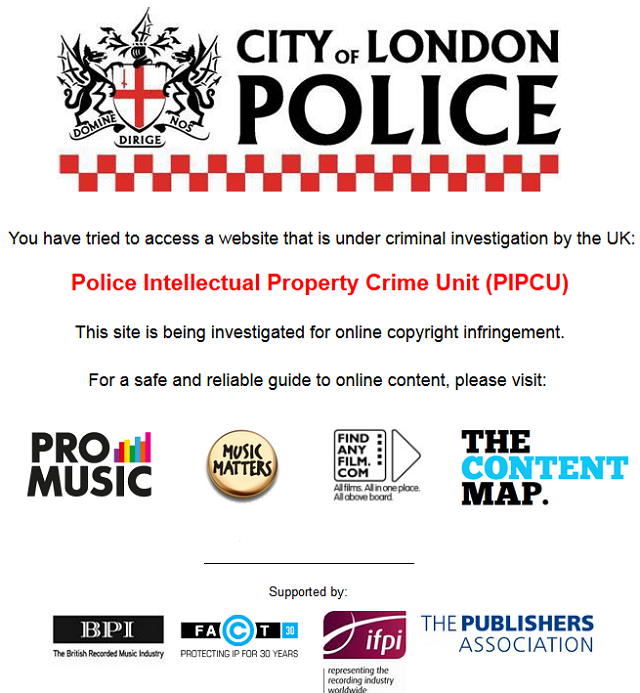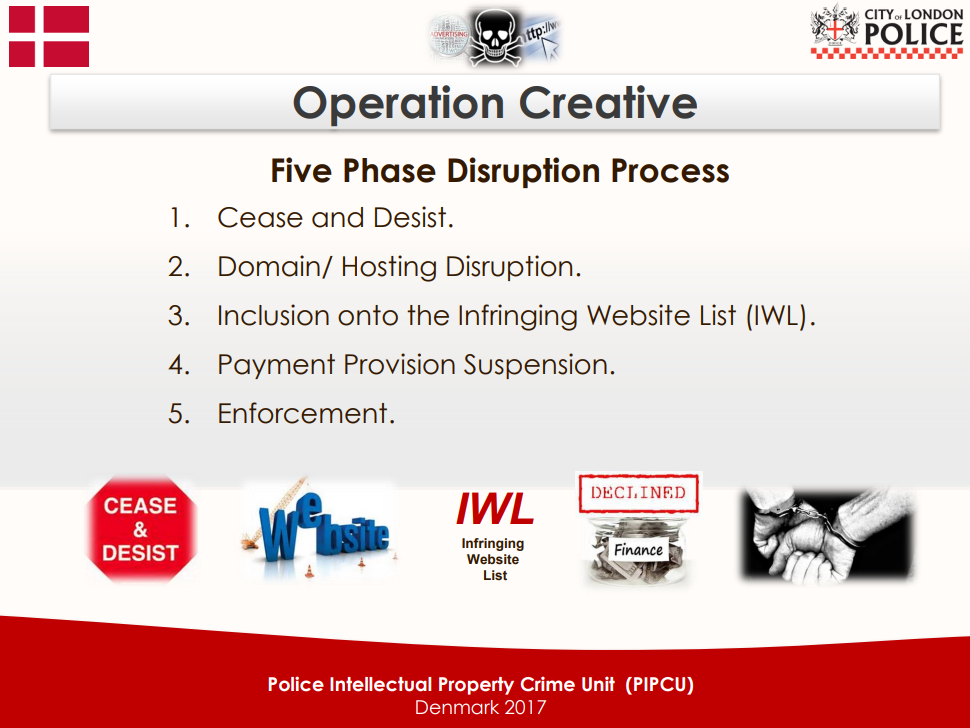 Launched to considerable fanfare late March 2014, the ‘Infringing Website List’ (IWL) is operated by the Police Intellectual Property Crime Unit (PIPCU).
Launched to considerable fanfare late March 2014, the ‘Infringing Website List’ (IWL) is operated by the Police Intellectual Property Crime Unit (PIPCU).
The IWL is one of the tools available under the banner ‘Operation Creative’, a multi-agency anti-piracy initiative led by police and supported by major rightsholders in the film, TV, music, publishing, and live sports sectors.
As publicly advertised, pirate site domains are nominated for placement on the IWL by rightsholder groups such as the MPA, BPI, IFPI, and the Publishers Association. Once police have carried out their own investigations, any domain subsequently added to the IWL finds itself blacklisted by most of the advertising industry.

The theory is that when pirate site operators face restrictions on their ability to generate revenue, shutting down completely may not be such a difficult choice, especially when payment processing disruption is next on the menu.
“IWL is Successful and Makes a Real Difference”
Whenever the IWL is promoted in public, it’s described as an all-round success story. Not only do pirate site operators make less money, advertisers benefit by a) not having their brands appear alongside pirated content and b) aren’t seen as funding illegal sites that other businesses want to shut down.
Since the advertisers themselves have thus far remained quiet, it’s possible that losing contact with millions of potential customers on pirate sites made no difference to their businesses; in reality, however, it’s impossible to say.
The criteria for a site being placed on the IWL is a secret, what happens after that isn’t for public consumption, and members of the public who filed persistent FOIA requests were left hanging for months before receiving little of value. At least in theory, the list is off-limits to journalists too.
It’s still not clear why the information is so sensitive; the world’s most notorious pirate sites are regularly called out in public in the U.S. and as far as we can tell, it makes little difference to their behavior.
IWL Still Receives Support
The reality is that there’s very little on the IWL to shock or surprise. More recently IPTV providers have been featured much more often, and the same goes for sites offering unlicensed access to books and other publications. Also featured more heavily are services that enable users to rip content from YouTube and similar platforms.
There have been one or two issues worth mentioning, but no big scandals to report on; except perhaps one.
 After a decade of solid work, saving rightsholders’ reputations and preventing millions from entering the piracy ecosystem, a few weeks ago the tenth anniversary of the Infringing Website List came and went without so much as a mention.
After a decade of solid work, saving rightsholders’ reputations and preventing millions from entering the piracy ecosystem, a few weeks ago the tenth anniversary of the Infringing Website List came and went without so much as a mention.
Today we’ll do our best to provide an overview of the current state of play, based in part on data made available over the past six months, and from other sources where applicable. Since almost no data is shared with the public, our estimates should be considered with that in mind.
Since its launch a decade ago, Operation Creative now receives considerable support. In addition to the MPA, IFPI/BPI, FACT, the Publishers Association, PRS for Music, and UKIE (Association for UK Interactive Entertainment), the advertising body ISBA, IAB (Internet Advertising Bureau UK) and IPA (Institute of Practitioners in Advertising), are now all on board.
Some IWL Facts and Figures
According to PIPCU data presented at the Digital Brand Protection Forum in Germany last November, but to our knowledge not shared publicly in the UK, over 4,200 referrals have been made to the IWL since its inception. Of those, around 2,000 sites have since been declared no longer active.

Whether that means no longer active from the blacklisted domain, or no longer active from any domains following a switch, we cannot confirm. Regardless, PIPCU’s presentation stated that 1,642 sites “were within the IWL portal” at that time.
Taking March 31, 2024, as our cutoff date (exactly 10 years from the day the IWL was first announced), we can confirm that the total number of entries on the Infringing Website List, each representing a fully-qualified domain, was 1,659.
The most recent domain added to the list before the end of March was a streaming site, the details of which we’ll return to shortly. The important thing here is its sequential reference number: CTV_7231. Following the usual format we can deduce that this was the 7,231st domain added to the IWL from inception, right through to March 31, 2024.
We can confirm there are no obvious gaps in the numbering system so since that is a considerable leap from the figures cited at the forum last year, it may mean that a referral can contain multiple domains. It might also be an error; again, hard to say.
Football Streaming Site IWL’s Longest Inmate
The site that has been present on the list for longest is soccer365.ru, reference CTV_0016. This suggests the streaming site was the 16th to be added to the IWL.
Still very much alive today, this football streaming site was added to the IWL on February 13, 2014, over a month before the IWL was officially announced. At the time of writing, the site has just two advertiser entries in its ads.txt and both relate to Google.
Whether any disruption measures have been deployed against soccer365 is unknown, but its traffic speaks for itself: it’s the #1 football site in Russia, the 167th most popular site in Russia, period, and during April it received 19.4 million visits.
Are There Synergies Between the Blacklist & Blocklist?
The Infringing Website List targets sites’ ability to generate revenue but has no ISP blocking component. Injunctions handed down by the High Court, on the other hand, consist only of blocking measures.
Given that the MPA, Publishers Association, and BPI are among the most prolific blocking injunction applicants, while also most likely to nominate platforms for financial disruption via the IWL, does the data show synergies between blocklist and blacklist?
Due to the growing trend of pirate sites deploying large numbers of subdomains to evade blocking, we filtered both lists so that less emphasis is placed on mostly temporary subdomains. Ultimately, the majority of these domains do not appear on the IWL so do not affect the outcome. However, the sheer scale of the main ISP list, culled and compiled from third-party sources, should be treated only as a ballpark estimate.
A comparison of the lists reveals the following:
Of the ~11,692 remaining FQDNs on the UK ISP (unofficial) blocklist and the ~1,604 remaining on the Infringing Website List, just 110 FQDNs are present on both lists.

If anyone is wondering how the IWL managed to shrink from 1,659 FQDNs to just 1,604, that’s mostly due to duplicate entries in the IWL being filtered out. We don’t intend to name them all here but the example below is typical, mostly caused by the presence (or absence) of https://, http://, and www. as a subdomain.
converto.re CTV_6997 Added to list: 15/02/2024
converto.re CTV_6791 Added to list: 28/11/2023
converto.re CTV_6316 Added to list: 07/03/2023
In total, two domains appear in the list three times each, and another 58 domains appear twice. All duplicates were removed here.
Une dernière chose…
Finally, there’s something a little unusual about the streaming site added to the IWL at the very end of March 2024, right around its anniversary.
The name of the site wasn’t immediately familiar to us here and since we don’t know the background – in particular why the platform had 9 million visits in March but only 6 million last month – naming it so soon would be inappropriate.
That being said, since we couldn’t access the site from two UK IP addresses or via a selection of VPNs, not to mention that it’s published entirely in French, it’s appearance on the UK-focused IWL seems odd. Add in the fact that it appears to enjoy almost no traffic from the UK, and its presence on the list seems even more unusual.
However, given user behavior at the site, specifically which platforms millions visit directly after leaving, the site’s eventual demise may not be quite the success story first imagined.






